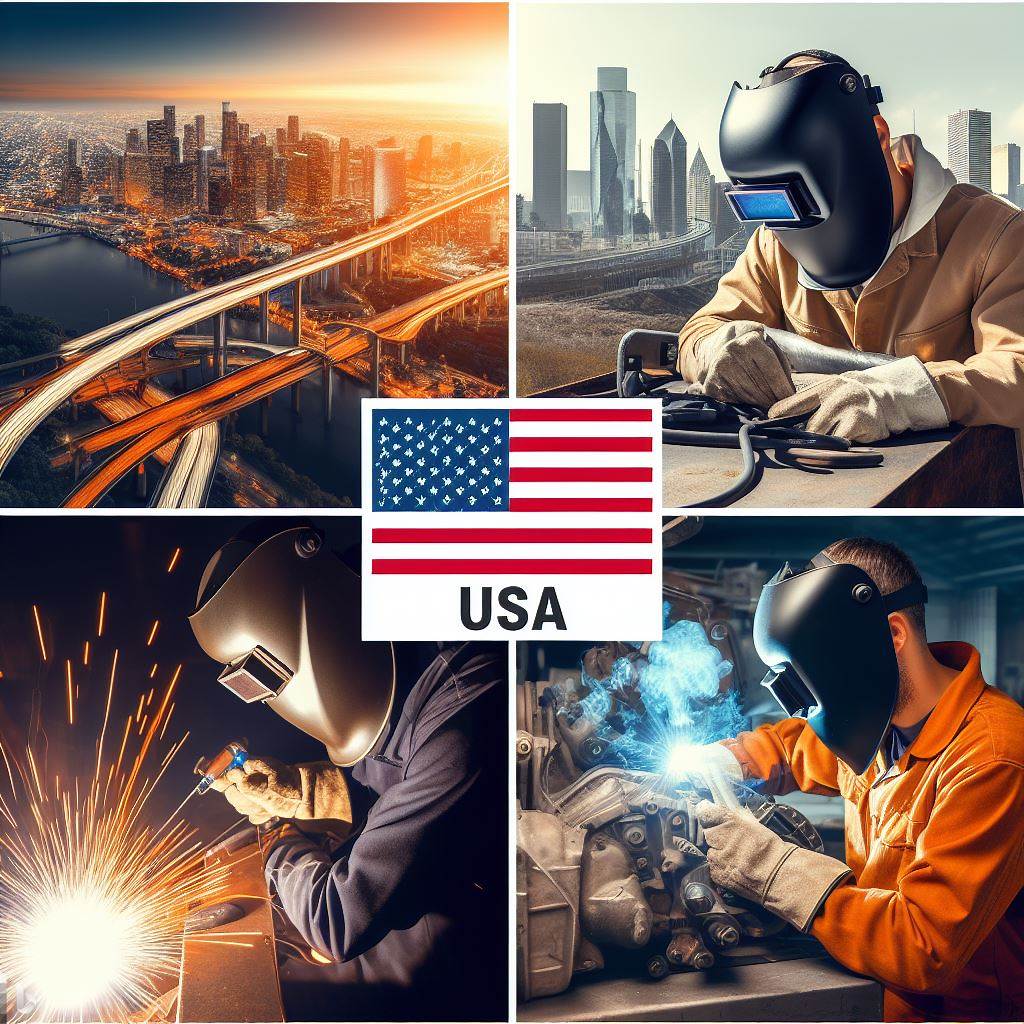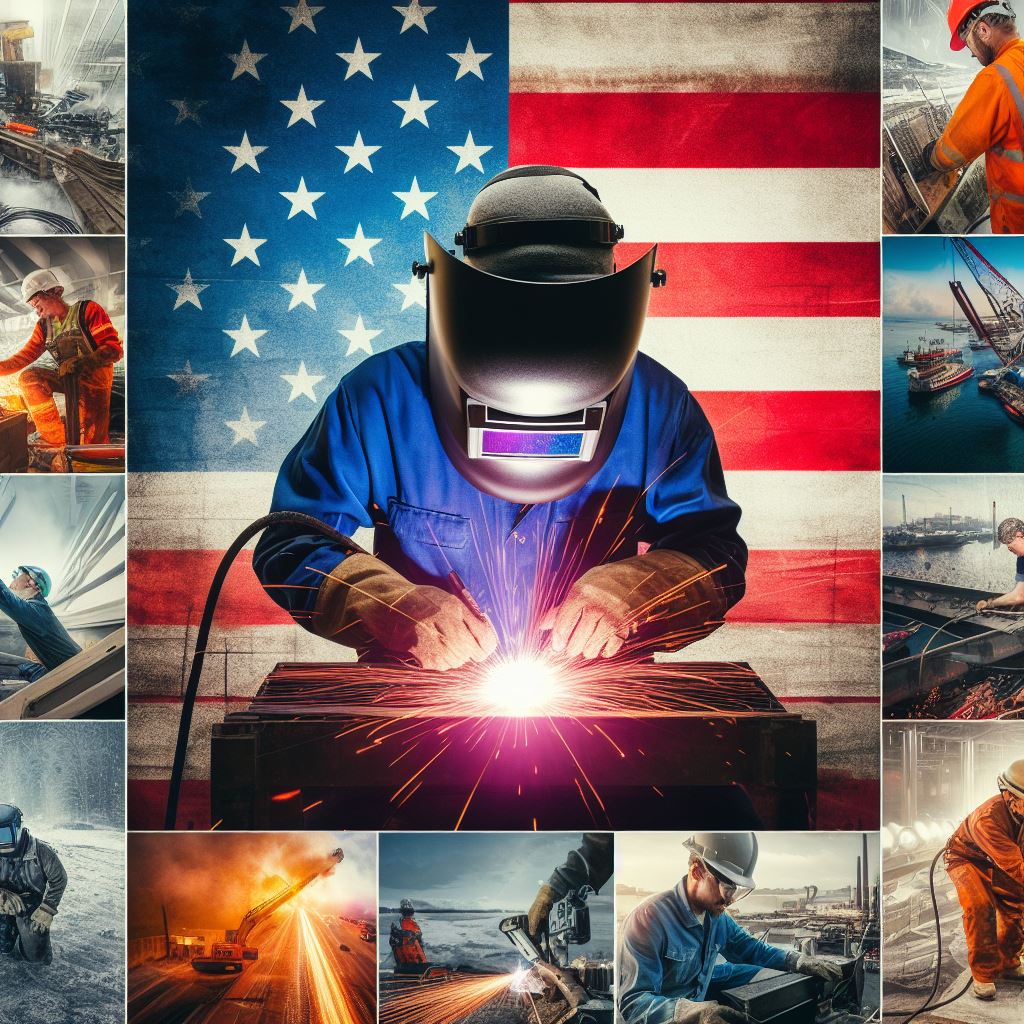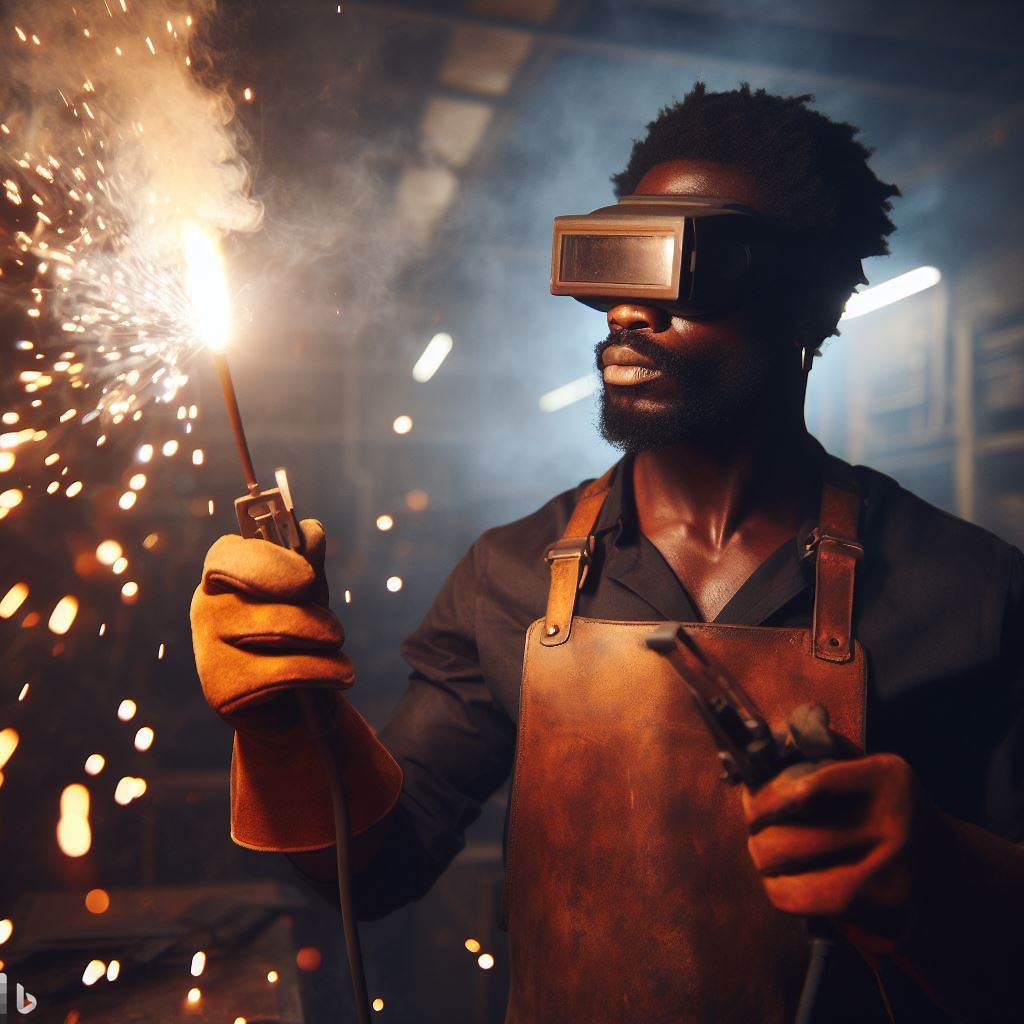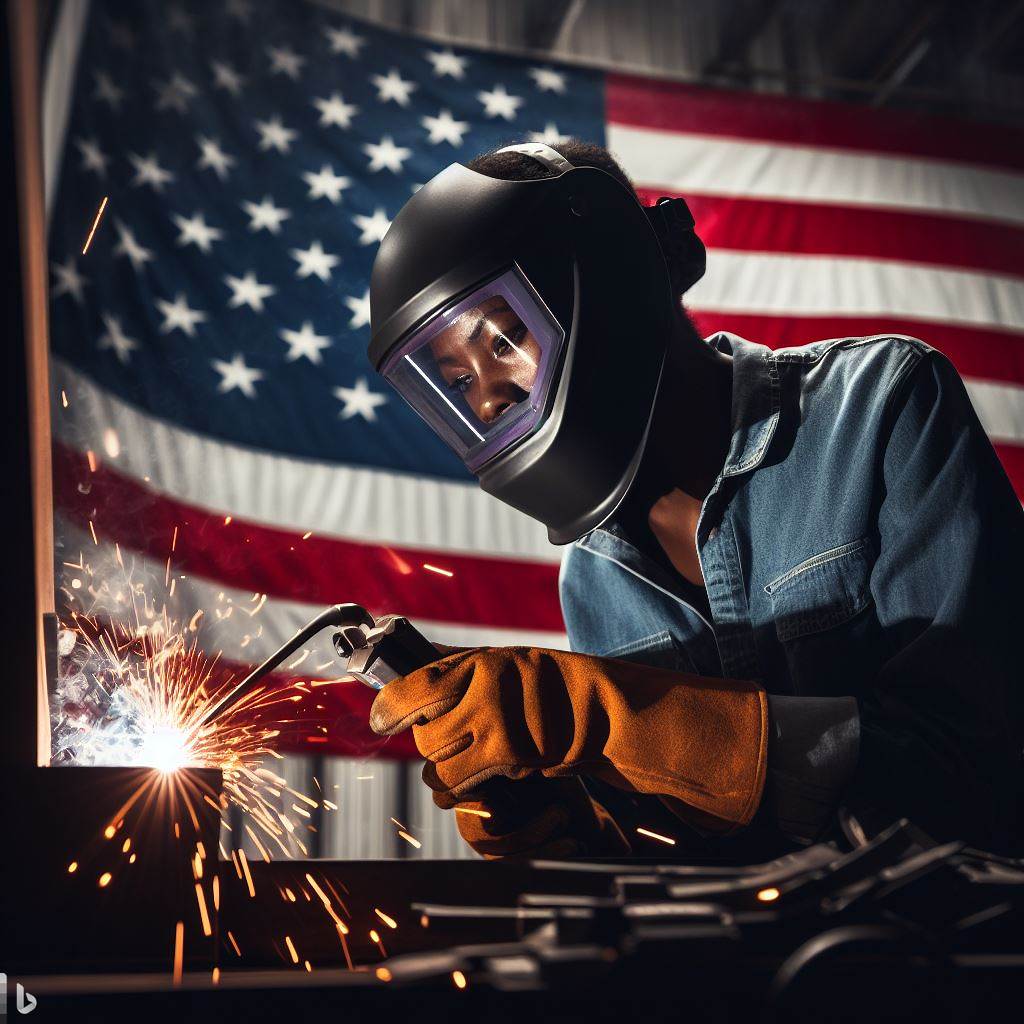Introduction
In modern society, welding holds immense importance as it plays a crucial role in various industries.
Its history can be traced back to ancient times, where it was used to join metals together.
However, it wasn’t until the 19th century that welding started to evolve into the complex and versatile process we know today.
The evolution of welding in the USA has had a profound impact on different industries.
It has revolutionized the way we build and manufacture, enabling us to create structures and products of unparalleled strength and durability.
One significant advancement in welding occurred during World War II when a technique called arc welding was introduced.
This method allowed for faster and more efficient production, meeting the demands of the war effort.
The post-war years saw further advancements, with the introduction of submerged arc welding and gas metal arc welding, providing even more versatility in the welding process.
Another key milestone in the evolution of welding was the development of robotic welding systems in the 1960s.
These automated systems increased productivity and precision, allowing for complex welding tasks to be completed with minimal human intervention.
Today, welding continues to evolve with the integration of advanced technologies such as laser welding and 3D printing.
These cutting-edge techniques have further expanded the capabilities of welding and opened up new possibilities for innovative design and manufacturing processes.
In essence, the evolution of welding in the USA has significantly impacted various industries and transformed the way we build and manufacture.
From its ancient origins to the present day, welding has continuously adapted and evolved, making it a vital process in modern society.
Early Origins of Welding
Discussion on the ancient techniques of welding
- Forge welding, where metal pieces are heated and hammered together to create a solid bond.
- Brazing, which involves using a filler material to join metal pieces together.
The first recorded use of welding in the USA
- The first recorded use of welding in the USA dates back to the 19th century.
- During the construction of the Eads Bridge in 1874, bridge engineer James Eads utilized welding techniques.
- Eads employed a process known as “thermit welding” to join the iron sections of the bridge.
- The concept of thermit welding involved using a mixture of aluminum and iron oxide to create a chemical reaction.
- This reaction produced molten iron, which was then used to bond the separate sections of the bridge together.
- Though primitive compared to modern welding methods, this marked an important milestone in welding history.
Discussion on the early developments and advancements in welding technology
- In the early 20th century, the development of electric arc welding revolutionized the welding industry.
- Russian engineer Vladmir Mitkevich invented the first electric arc welding method in 1888.
- This technique utilized electric current to create an arc between the welding electrode and the workpiece.
- The arc heat melts the metal, forming a weld joint when the molten metal cools and solidifies.
- Electric arc welding became widely used in various industries, including shipbuilding and construction.
- In 1920, P.O. Nobel developed an electrode that utilized a flux coating, resulting in a more stable arc.
- This advancement allowed for improved weld quality and reduced the need for costly welding repairs.
Discussion on the impact of welding in the industrial development of the USA
- The widespread adoption of welding techniques played a significant role in the industrial development of the USA.
- Welding enabled the construction of large structures, such as bridges, skyscrapers, and manufacturing plants.
- It allowed for the mass production of automobiles, ships, and aircraft, driving technological advancements.
- The welding industry also created numerous job opportunities, contributing to economic growth in the country.
- During World War II, welding became instrumental in the production of military equipment and vehicles
. - This led to increased demand for skilled welders and further advancements in welding technology.
- Overall, welding has been crucial to the progress and success of the USA’s industrial sector.
In fact, the early origins of welding can be traced back to ancient techniques like forge welding and brazing.
The first recorded use of welding in the USA occurred during the construction of the Eads Bridge in 1874, utilizing a process known as thermit welding.
The development of electric arc welding in the early 20th century revolutionized the industry and contributed to the industrial development of the USA.
Welding played a crucial role in the construction of large structures, mass production, and the country’s wartime efforts.
Its impact on the economy and technological advancements cannot be overstated.
The Industrial Revolution and Technological Advancements
Increased Demand for Welding
During the Industrial Revolution, the need for welding grew exponentially as industries expanded rapidly.
As factories and manufacturing plants boomed, welding became vital for construction, machinery, and infrastructure.
Transform Your Career Today
Unlock a personalized career strategy that drives real results. Get tailored advice and a roadmap designed just for you.
Start NowWelding enabled the joining of metal components, providing the strength and durability necessary for the era’s innovations.
The demand for skilled welders skyrocketed, paving the way for welding to become a respected profession.
Introduction of New Welding Methods and Equipment
This era witnessed significant breakthroughs in welding technology, revolutionizing the industry in numerous ways.
Advancements by Thomas Edison and Nikolai Benardos
Thomas Edison, renowned for his electrical inventions, also contributed to welding’s progression.
In 1881, he patented a method called “Electric Arc Welding,” utilizing an electrode holder to create arc welding.
This invention revolutionized welding, making it faster, more efficient, and less dependent on expert craftsmanship.
Nikolai Benardos, a Russian inventor, independently developed an arc welding method around the same time.
Benardos’ technique was remarkably similar to Edison’s, combining a carbon arc and an electrode holder for joining metals.
Electric arc welding, introduced by both Edison and Benardos, proved to be a game-changer for the industry.
It allowed for the creation of stronger weld joints and increased productivity, giving rise to large-scale welding operations.
Advancements in arc welding technology continued throughout the Industrial Revolution, with improvements in power supplies and electrode materials.
Advancements in Power Supplies
To meet the growing demand for welding, power supplies underwent significant improvements.
Generators capable of producing stronger electric currents were developed, providing more heat for welding operations.
These higher currents resulted in deeper weld penetration and facilitated welding thicker materials.
Advancements in Electrode Materials
The introduction of new electrode materials further enhanced welding techniques.
Initially, carbon electrodes were used, but they had limitations, such as high consumption rates and limited effectiveness.
Welders sought more durable and efficient options, leading to the discovery and adoption of metal electrodes.
Metal electrodes, notably made of copper or iron, greatly improved welding quality and efficiency.
Overall, the Industrial Revolution fueled the demand for welding, prompting the introduction of new methods and equipment.
Showcase Your Business Today
Reach thousands of readers actively exploring professional services. Publish your business profile and grow your audience now.
Publish NowEdison and Benardos played crucial roles in revolutionizing welding with their inventions, advancing the profession.
The improvements in arc welding technology, power supplies, and electrode materials allowed for even greater industrial growth.
As the USA embraced technological advancements, welding became an integral part of the nation’s progress.
World Wars and the Rise of Arc Welding
Impact of World War I on welding technology
- Increased demand for welding due to the need for military equipment and vehicles.
- Welding techniques improved and became more efficient to meet wartime production demands.
- Introduction of gas welding and the oxyacetylene torch for joining metals.
Development of arc welding
- The US Navy played a crucial role in the development of arc welding during World War I.
- The Navy needed a fast and efficient method to repair damaged ships, leading to the advancement of arc welding.
- Thomas Edison and others contributed to the development of arc welding processes.
The Lincoln Electric Company played a significant role in the advancement of arc welding.
They developed the first welding machine that could produce a consistent arc, leading to more reliable welds.
Significant role of welding in World War II
- The demands of World War II increased the need for welding in shipbuilding, tank production, and aircraft manufacturing.
- Welding became an essential skill for the war effort, leading to the establishment of welding schools and training programs.
- Advances in welding technology allowed for the construction of complex military structures, such as bridges and bunkers.
Welding played a vital role in World Wars I and II by strengthening military equipment and infrastructure.
The demand for welding surged during both wars as gas welding and the oxyacetylene torch enhanced efficiency.
Welding methods improved, aiding quick repairs and construction of military machinery.
In World War II, the need for ships, tanks, and aircraft led to the establishment of welding schools.
Arc welding advanced significantly, with the US Navy and visionaries like Thomas Edison contributing.
The Lincoln Electric Company’s breakthrough with a consistent electric arc revolutionized welding technology.
The demands of the war necessitated complex military structures, relying on reliable welds, which welding technology facilitated.
In general, the wars drove the development of new welding techniques, making welding an essential skill for the war effort and military infrastructure construction.
Read: The Historical Evolution of Carpentry in the USA: A Deep Dive
Post-War Innovations and Automation
Changes in Welding Techniques during the Post-War Period
During the post-war period, significant advancements were made in welding techniques and technologies.
Introduction to Automation in Welding
Automation, a revolutionary concept, gained prominence in the welding industry during this era.
Automation of Welding Processes in Industries
Industries started embracing automation as it improved productivity, efficiency, and quality of welding processes.
Advancements in Robotic Welding Technology
The post-war period brought revolutionary progress in robotic welding technology, reshaping the welding industry profoundly.
Substantial transformations occurred post-World War II, impacting welding techniques and technologies significantly, paving the way for automation, transforming welding across industries.
Advancements in welding techniques during this era were remarkable, driven by new materials and technologies, fostering innovative welding methods.
The introduction of advanced equipment like gas metal arc welding (GMAW) and flux-cored arc welding (FCAW) boosted welding quality and efficiency.
Semiautomatic and automatic welding equipment emerged, enabling faster and more precise welding, enhancing productivity, and standardizing processes, resulting in better weld quality.
Expanding post-war industries fueled demand for efficient, cost-effective welding, ushering in automation.
Automation employs technology and machinery for minimal human intervention, bringing numerous benefits like continuous welding, reduced downtime, and improved weld quality.
Specialized equipment, including welding robots, gained popularity, excelling in repetitive, precise tasks, programmed to handle complex welding, thus increasing efficiency and reducing human error.
Robotic welding technology saw pivotal advancements with computer numerical control (CNC) systems allowing precise control and programming of robotic welders.
Ensuring higher accuracy in weld placement and overall weld quality.
Manufacturers leveraged robotic welding for intricate, previously manual welding processes, lowering labor costs and accelerating production, bolstering competitiveness.
Basically, the post-war era marked a turning point, introducing automation into the welding industry, enhancing productivity, efficiency, and weld quality.
Robotic welding technology’s advances were instrumental, revolutionizing welding and paving the way for further field advancements.
Read: Emerging Tech: How Automation Impacts Carpentry in the US
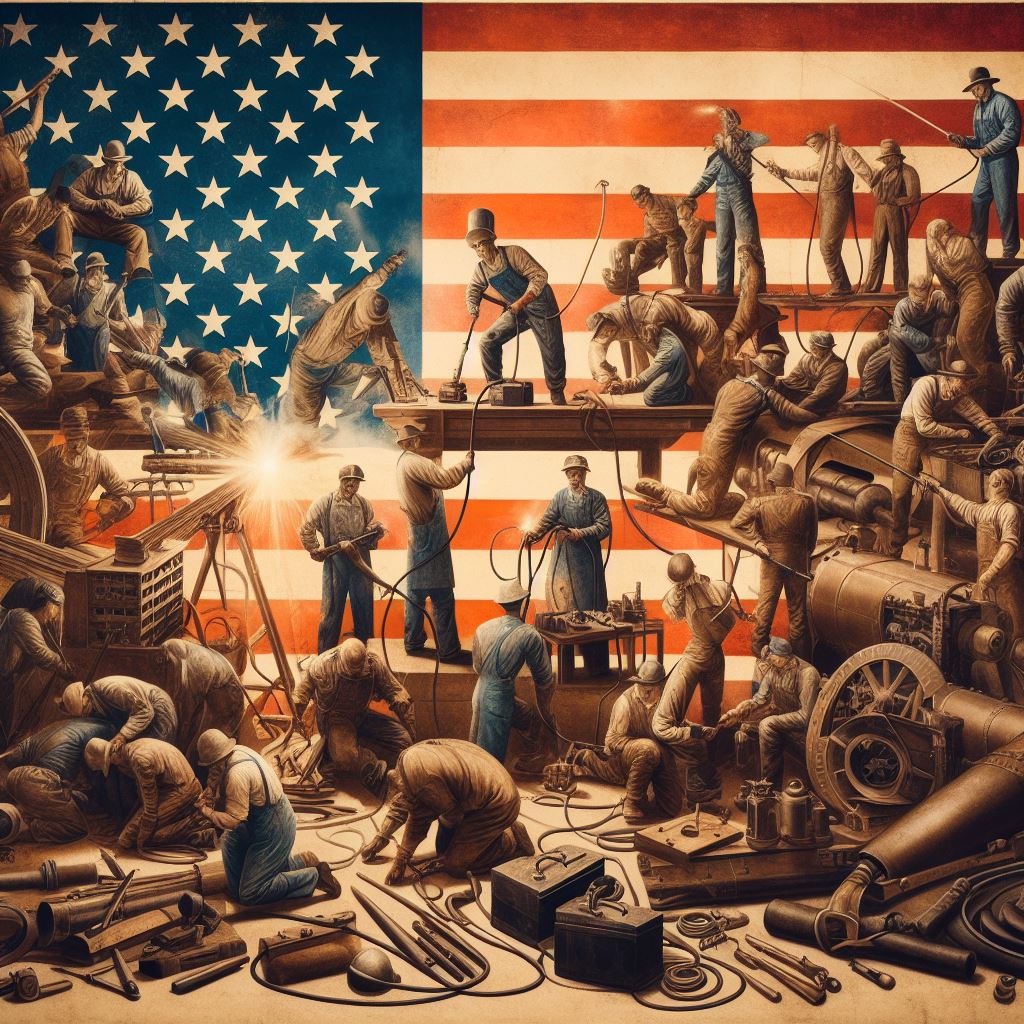
Advancements in Welding Materials and Techniques
In recent years, the field of welding has witnessed significant advancements in both materials and techniques.
This section will explore the use of new materials, such as stainless steel and aluminum, in welding.
As well as the development of innovative welding techniques like gas metal arc welding (GMAW) and gas tungsten arc welding (GTAW).
Use of New Materials in Welding
One of the key areas of progress in welding has been the introduction of new materials that offer superior properties for various applications.
Stainless steel and aluminum, in particular, have gained popularity in welding due to their unique characteristics.
Stainless steel, known for its corrosion resistance and strength, has become a common choice in industries ranging from aerospace to automotive.
Its ability to withstand extreme temperatures and aggressive environments has made it invaluable for constructing aircraft components, pipelines, and pressure vessels.
Similarly, aluminum has emerged as a preferred material for welding due to its excellent strength-to-weight ratio and exceptional thermal conductivity.
It is widely used in industries like construction, automotive, and marine, where lightweight yet durable structures are crucial.
Showcase Your Business Today
Reach thousands of readers actively exploring professional services. Publish your business profile and grow your audience now.
Publish NowThe use of these new materials has revolutionized welding applications, allowing for the construction of stronger, more efficient, and longer-lasting structures.
Development of New Welding Techniques
In addition to new materials, advancements in welding techniques have significantly contributed to the evolution of this field.
Two notable techniques that have gained prominence are gas metal arc welding (GMAW) and gas tungsten arc welding (GTAW).
GMAW, also known as MIG (Metal Inert Gas) welding, is a process that utilizes a continuously fed wire electrode to form a weld pool between the workpieces.
It is widely used in industries such as manufacturing, construction, and automotive due to its versatility, high welding speed, and ease of automation.
On the other hand, GTAW, commonly referred to as TIG (Tungsten Inert Gas) welding, employs a non-consumable tungsten electrode to produce the weld.
This technique offers precise control over the welding process and is often used for welding thin sections, critical joints, and exotic materials in industries like aerospace and nuclear power.
These advanced welding techniques have expanded the possibilities in terms of welding applications, enabling the fabrication of complex structures with exceptional quality and precision.
In addition, advancements in welding materials, such as stainless steel and aluminum, have opened up new avenues for various industries.
Furthermore, the development of innovative techniques like GMAW and GTAW has revolutionized the welding process, providing enhanced efficiency, versatility, and quality.
As technology continues to progress, the future of welding holds even more exciting possibilities.
Read: Safety Protocols: Best Practices in American Carpentry
Impact of Welding on Various Industries
Construction and Infrastructure Development
Welding plays a crucial role in the construction and development of infrastructure projects.
It enables the joining of metal components, creating strong and durable structures.
Welding ensures the integrity and stability of buildings, bridges, and highways, providing safety to the public.
From skyscrapers to dams, welding is essential in constructing projects that withstand extreme conditions and natural disasters.
The advancements in welding techniques have allowed for the construction of complex and innovative architectural designs.
Increased efficiency and speed in welding have significantly contributed to the progress of construction projects, saving time and resources.
Automotive and Aerospace Industries
The automotive and aerospace industries heavily rely on welding for manufacturing vehicles and aircraft.
Welding is used in the assembly of car bodies, ensuring structural integrity and safety for passengers.
In the aerospace industry, precision welding techniques are essential for constructing aircraft components.
Welding is vital in the fabrication of engine parts, fuel tanks, landing gears, and aerospace frames.
The development of lightweight materials and advanced welding methods has improved fuel efficiency and increased aircraft performance.
Through continuous advancements, welding has enabled the creation of stronger and lighter vehicles and aircraft.
Shipbuilding and Oil Refineries
In shipbuilding, welding is critical for constructing large vessels, such as cargo ships, tankers, and cruise liners.
Welding ensures the watertight integrity of ships, preventing leaks and ensuring the safety of crew and passengers.
Shipbuilding also requires welders to join various types of metals to create strong and durable structures.
Oil refineries rely on welding for the fabrication and maintenance of equipment used in the refining process.
Welding ensures the integrity of pipelines, storage tanks, and pressure vessels, preventing leaks and accidents.
The use of automated welding systems in oil refineries has improved efficiency and safety, minimizing human error.
Essentially, welding has a significant impact on various industries, including construction, automotive, aerospace, shipbuilding, and oil refineries.
In construction, welding allows for the creation of durable and safe structures that withstand extreme conditions.
Also, the automotive and aerospace industries, welding is essential for manufacturing vehicles and aircraft, contributing to their strength and performance.
In shipbuilding and oil refineries, welding plays a crucial role in ensuring the integrity and safety of vessels and equipment.
The continuous advancements in welding techniques and equipment have revolutionized these industries, providing efficiency and reliability.
Read: Key Tools and Techniques Every US Carpenter Should Know
Future Trends in Welding
Discuss the current innovations and research in welding technology
- Laser welding: Emerging as a popular technique due to its precision and speed.
- Friction stir welding: Joining metals without melting, reducing distortion and enhancing strength.
- 3D printing: Utilizing additive manufacturing to create complex weld structures.
- Hybrid welding: Combining different welding processes to optimize efficiency and quality.
- Remote welding: Employing robotics and automation for improved safety and productivity.
- Augmented reality: Using AR technology to guide welders and enhance their skills.
Predict potential future advancements in welding techniques and equipment
- Nanotechnology integration: Enhancing weld strength and durability through nanomaterials.
- Smart welding systems: Equipping welders with intelligent robots and sensors for real-time monitoring.
- Virtual reality training: Simulating welding scenarios for skill development and reduced training time.
- Energy-efficient welding: Developing eco-friendly methods with reduced energy consumption.
- Internet of Things (IoT) integration: Connecting welding equipment for data analysis and predictive maintenance.
- Automated inspection: Implementing automated systems for quality control and defect detection.
- Lightweight materials welding: Advancing techniques to join new lightweight materials like aluminum, magnesium, and composites.
- High-speed welding: Improving welding processes to achieve faster cycle times without compromising quality.
- Non-destructive testing: Incorporating advanced inspection methods to ensure weld integrity without damaging the weld.
- Hydrogen fuel cell welding: Investigating the potential of this clean energy source for welding applications.
Generally, the future of welding holds exciting possibilities. Innovations like laser welding, 3D printing, and augmented reality are already transforming the industry.
As research progresses, advancements such as nanotechnology integration, IoT connectivity, and high-speed welding are expected to revolutionize welding techniques and equipment.
With a focus on sustainability and efficiency, the welding industry is poised to embrace green technologies and further enhance the quality and productivity of welds.
As we move forward, it is important to adapt and embrace these future trends to stay at the forefront of the evolving welding landscape.
Showcase Your Business Today
Reach thousands of readers actively exploring professional services. Publish your business profile and grow your audience now.
Publish NowConclusion
To recap, this blog post discussed the evolution of welding in the USA.
It traces the historical development of welding techniques. From the early days of manual welding to the modern automated methods.
It showcases how welding technology has advanced, enabling efficient and precise metal joining processes.
The blog emphasizes the significant role of welding in various industries.
It outlines how American welding standards and regulations have evolved to ensure safety and quality.
It discusses the integration of innovative materials and welding technologies for improved results.
The post also underscores the importance of skilled welders in the ever-evolving field of metal fabrication.
It delves into the transformative journey of welding in the United States, shaping industries and infrastructure.
It emphasized the continuous evolution and importance of welding in the country.
Welding in the USA continually evolves, retaining its pivotal role in various industries.
It drives innovation, joining materials efficiently.
This versatile technique enhances manufacturing, construction, and infrastructure, promoting economic growth.
Welding advancements, such as automation and robotics, increase precision and productivity.
Skilled welders remain in high demand, contributing to a strong job market.
The USA’s commitment to welding education and research ensures a prosperous future for this vital craft.
Understanding the historical overview of welding is significant in appreciating its significance in today’s world.
Exploring the past, we grasp the importance of safety and quality standards, vital in today’s welding industry.
A historical perspective underscores welding’s role in infrastructure development and technological advancements, inspiring future innovations.
Knowledge of its past helps welders adapt to changing materials and demands in today’s dynamic world.
It underscores the timeless nature of welding as a fundamental human endeavor, connecting the past with the future.
This historical comprehension empowers us to appreciate and continue the legacy of welding, ensuring its significance endures.
[E-Books for Sale]
The Big Book of 500 High-Paying Jobs in America: Unlock Your Earning Potential
$19.99 • 500 High-Paying Jobs • 330 pages
Explore 500 high-paying jobs in America and learn how to boost your career, earn more, and achieve success!
See All 500 High-Paying Jobs of this E-Book
1001 Professions Without a Degree: High-Paying American Jobs You Can Start Now
$19.99 • 1001 Professions Without a Degree • 174 pages
Discover 1001 high-paying jobs without a degree! Unlock career tips, skills, and success strategies for just $19.99!

